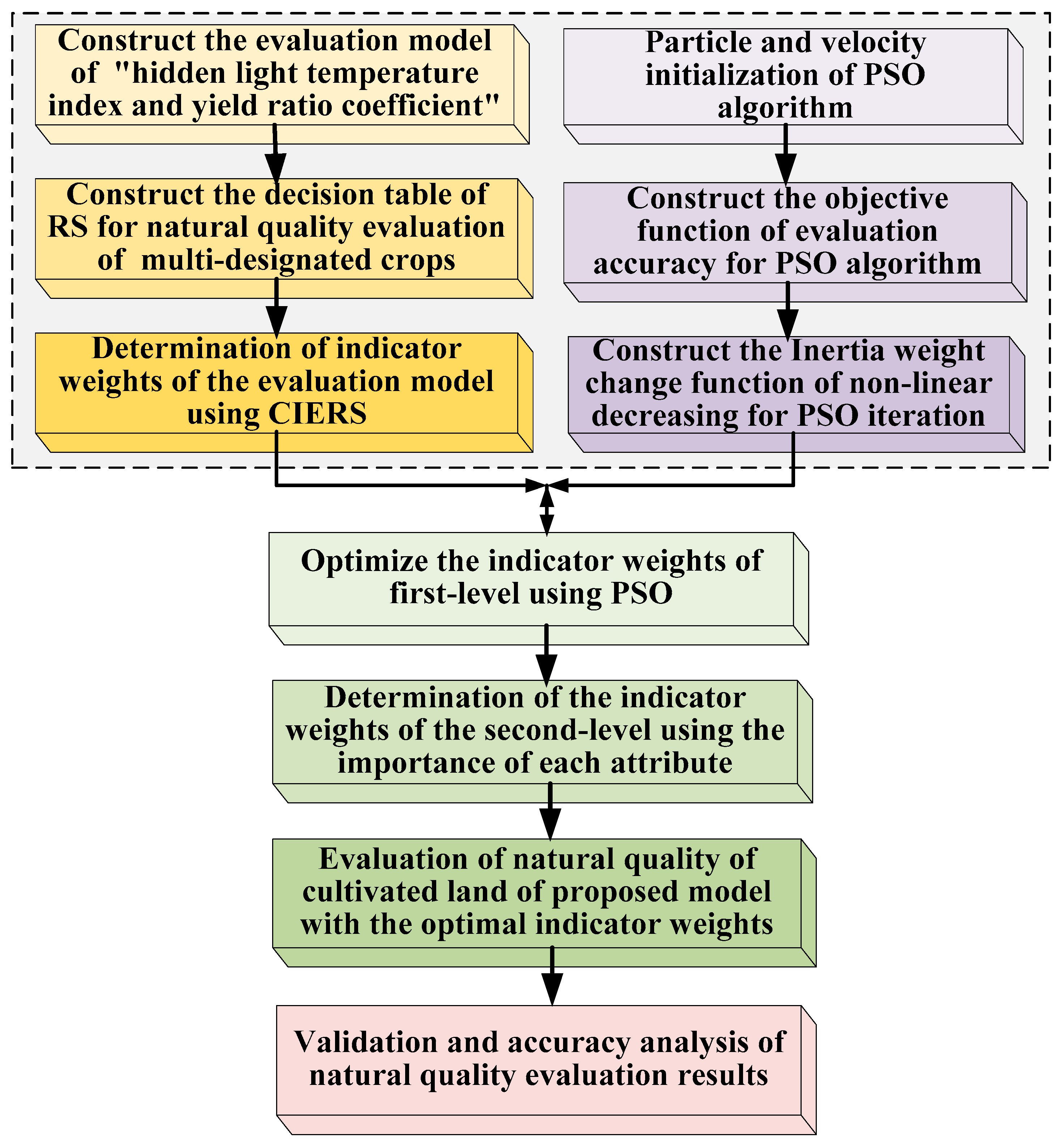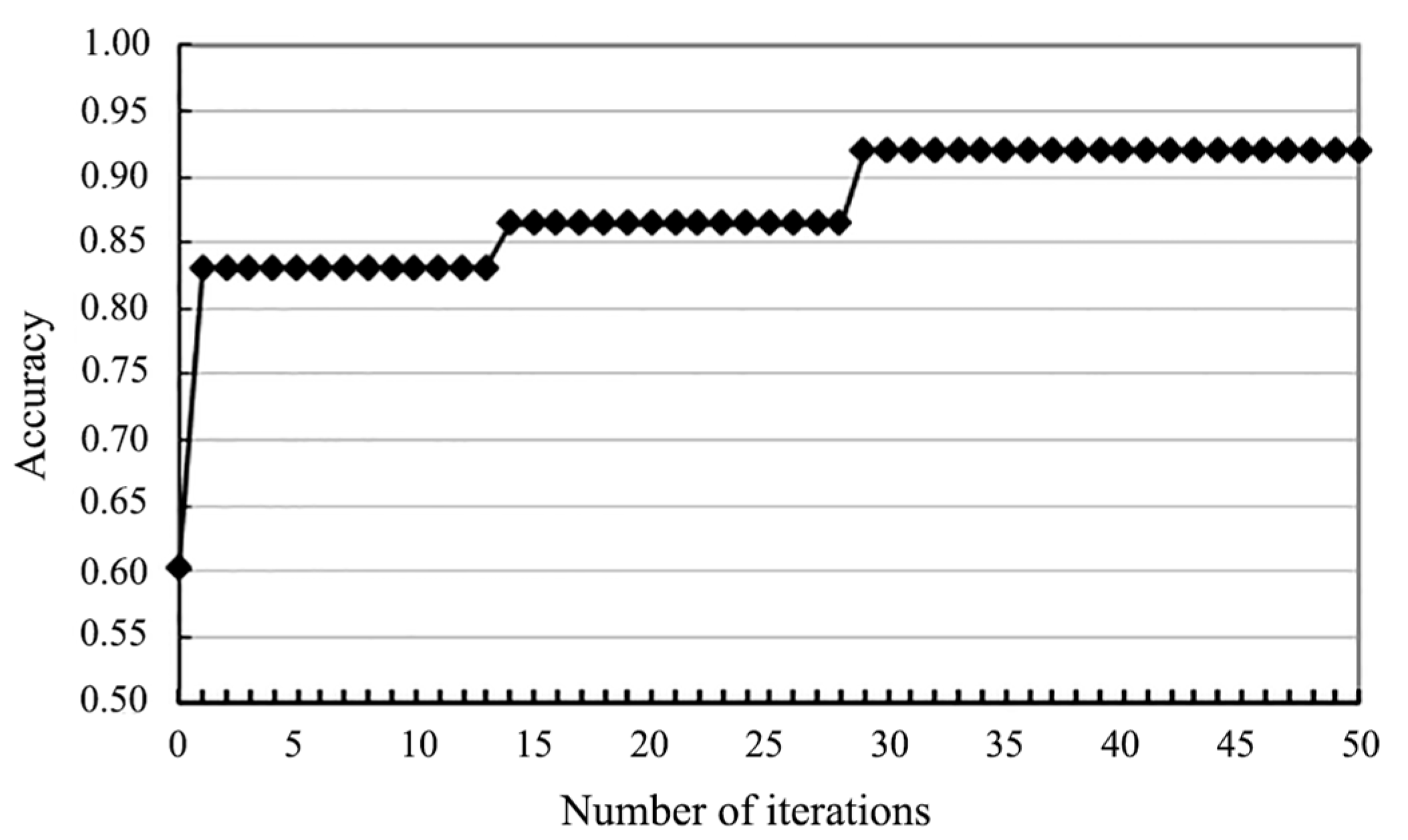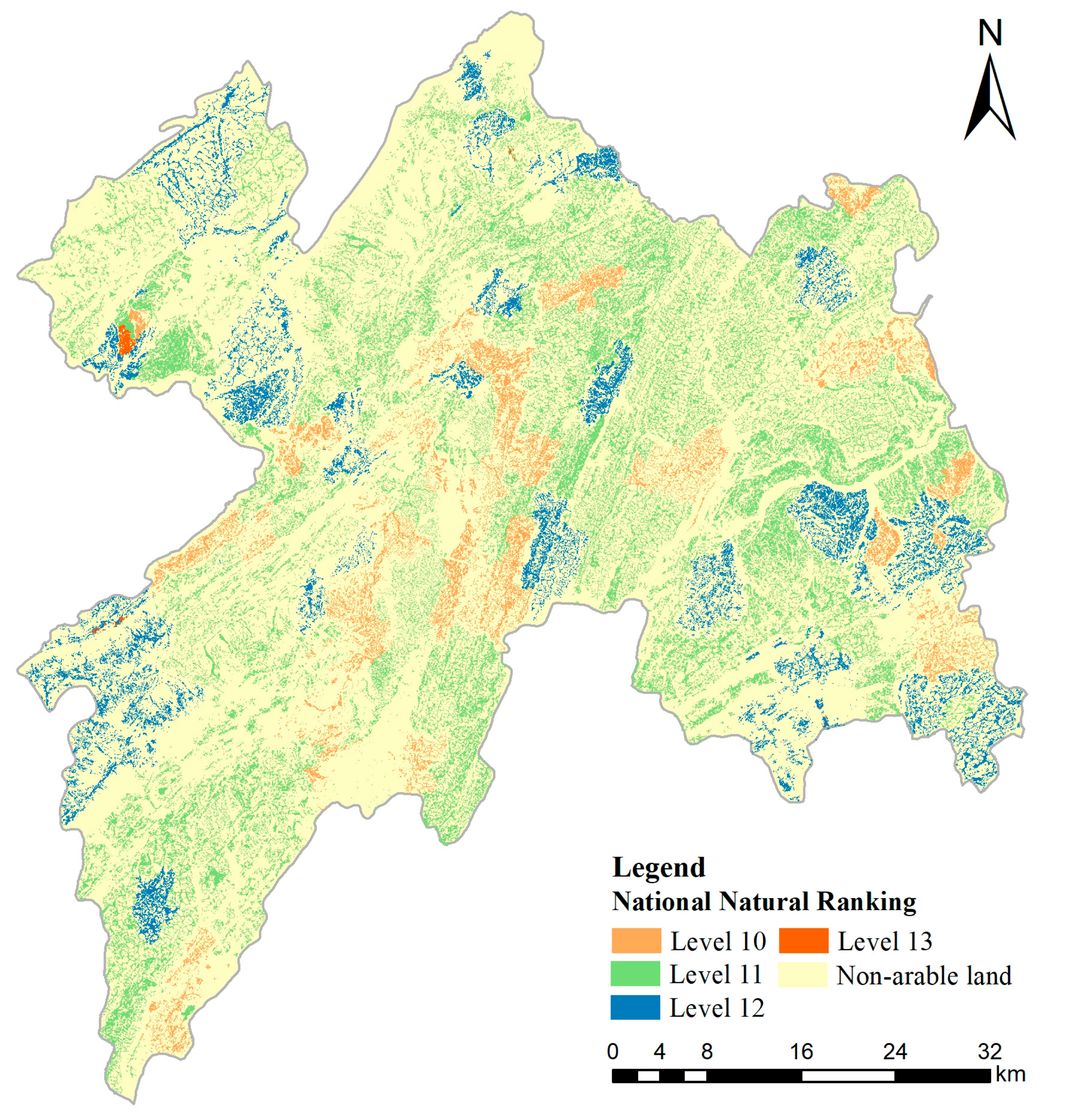Condition Information Entropy and Rough Set Method Based on Particle Swarm Optimization Applied in the Natural Quality Evaluation of Cultivated Land
Abstract
:1. Introduction
2. Study Area and Data Sources
2.1. Overview of the Study Area
2.2. Data Preparation and Pre-Processing
3. Research Methodology
3.1. The ”Hidden Light–Temperature Index and Yield Ratio Coefficient” Method
3.2. Rough Set Conditional Information Entropy Methods
3.2.1. Constructing a Decision Table
3.2.2. Determination of Indicator Weights
3.3. The Rough Set Conditional Information Entropy Evaluation Method Based on Particle Swarm Optimization
3.3.1. Constructing the Objective Function
3.3.2. Optimizing First-Level Indicator Weights by PSO
4. Results
5. Discussion
6. Conclusions
- (1)
- The “hidden light–temperature index and yield ratio coefficient” method was used to transform the original cultivated land natural quality evaluation model mathematically. It is conducive to adopting the RS conditional information entropy method in the evaluation of the natural quality of cultivated land.
- (2)
- The RS conditional information entropy method based on PSO can achieve a high evaluation accuracy even with a small sample. It overcomes the limitation of the RS conditional information entropy method being insensitive to the first-level indicator, and makes the evaluation results of the natural quality of cultivated land more accurate and reliable.
- (3)
- The spatial distribution of the cultivated land in Enshi is largely affected by the local topography. Cultivated land in high-altitude areas has poor quality, and the condition of cultivated land resources is not promising.
Author Contributions
Funding
Institutional Review Board Statement
Informed Consent Statement
Data Availability Statement
Conflicts of Interest
References
- Ministry of Natural Resources of the People’s Republic of China. Available online: https://www.mnr.gov.cn/dt/ywbb/202108/t20210826_2678340.html (accessed on 8 January 2024).
- The Central People’s Government of the People’s Republic of China. Available online: http://www.gov.cn/zhengce/2017-01/23/content_5162649.htm (accessed on 8 January 2024).
- Li, Y.H.; Li, Y.R.; Westlund, H.; Liu, Y.S. Urban–rural transformation in relation to cultivated land conversion in China: Implications for optimizing land use and balanced regional development. Land Use Policy 2015, 47, 218–224. [Google Scholar] [CrossRef]
- Han, B.; Jin, X.B.; Jin, J.X.; Xu, W.Y.; Ren, J.; Zhou, Y.K. Monitoring and classifying cropland productivity degradation to support implementing land degradation neutrality: The case of china. Environ. Impact Asses. 2023, 99, 107000. [Google Scholar]
- Regulation for Gradation on Agriculture Land Quality; Standards Press of China: Beijing, China, 2012.
- Zhao, D.; Dong, J.Y.; Ji, S.P.; Huang, M.S.; Quan, Q.; Liu, J. Effects of Contemporary Land Use Types and Conversions from Wetland to Paddy Field or Dry Land on Soil Organic Carbon Fractions. Sustainability 2020, 12, 2094. [Google Scholar] [CrossRef]
- Li, Y.S.; Chang, C.Y.; Zhao, Y.C.; Wang, Z.R.; Li, T.; Li, J.W.; Dou, J.; Fan, R.; Wang, Q.; Yang, J.; et al. Evaluation System Transformation of Multi-Scale Cultivated Land Quality and Analysis of Its Spatio-Temporal Variability. Sustainability 2021, 13, 10100. [Google Scholar] [CrossRef]
- Tang, M.M.; Wang, C.T.; Ying, C.Y.; Mei, S.; Tong, T.; Ma, Y.H.; Qing, W. Research on Cultivated Land Quality Restriction Factors Based on Cultivated Land Quality Level Evaluation. Sustainability 2023, 15, 7567. [Google Scholar] [CrossRef]
- An, P.L.; Chen, S.Y.; Meng, L.J.; Jiang, L. Determination of standard farming system in cultivated land classification of the third national land survey. J. China Agric. Univ. 2020, 25, 61–72. (In Chinese) [Google Scholar]
- Zhou, J.; Li, P.P.; Wang, J.Z. Effects of Light Intensity and Temperature on the Photosynthesis Characteristics and Yield of Lettuce. Horticulturae 2022, 8, 178. [Google Scholar] [CrossRef]
- Hwang, H.; An, S.; Pham, M.D.; Cui, M.Y.; Chun, C. The Combined Conditions of Photoperiod, Light Intensity, and Air Temperature Control the Growth and Development of Tomato and Red Pepper Seedlings in a Closed Transplant Production System. Sustainability 2020, 12, 9939. [Google Scholar] [CrossRef]
- Zhao, H.W.; Zhu, Y.Q.; Li, M.; Yang, H.M. The correlation of light—Temperature indexes and light—Temperature potential productivity of spring maize. In Proceedings of the 2015 23rd International Conference on Geoinformatics, Wuhan, China, 19–21 June 2015. [Google Scholar]
- Qian, F.K.; Lal, R.; Wang, Q.B. Land evaluation and site assessment for the basic farmland protection in Lingyuan County, Northeast China. J. Clean. Prod. 2021, 314, 128097. [Google Scholar] [CrossRef]
- Shaloo; Bisht, H.; Jain, R.; Singh, R.P. Cropland suitability assessment using multi criteria evaluation techniques and geo-spatial technology: A review. Indian J. Agric. 2022, 92, 554–562. [Google Scholar] [CrossRef]
- Shokr, M.S.; Abdellatif, M.A.; Baroudy, A.A.E.; Elnashar, A.; Ali, E.F.; Belal, A.A.; Attia, W.; Ahmed, M.; Aldosari, A.A.; Szantoi, Z.; et al. Development of a spatial model for soil quality assessment under arid and semi-arid condition-s. Sustainability 2021, 13, 2893. [Google Scholar] [CrossRef]
- Jiang, Y.; Wang, J.; Teng, H.; Li, H.L. Coupling coordination analysis of the quality evaluation of cultivated land and soil erosion in typical black soil areas using TOPSIS method. Trans. CSAE 2023, 39, 82–94. (In Chinese) [Google Scholar]
- Samaei, F.; Emami, H.; Lakzian, A. Assessing soil quality of pasture and agriculture land uses in Shandiz county, northwestern Iran. Ecol. Indic. 2022, 139, 108974. [Google Scholar] [CrossRef]
- Zhao, R.; Wu, K.; Li, X.L.; Gao, N.; Yu, M. Discussion on the unified survey and evaluation of cultivated land quality at county scale for china’s 3rd national land survey: A case study of wen county, henan province. Sustainability 2021, 13, 2513. [Google Scholar] [CrossRef]
- Zhang, Y.H.; Wang, L.; Jiang, J.; Zhang, J.C.; Zhang, Z.M.; Zhang, M.X. Application of soil quality index to determine the effects of different vegetation types on soil quality in the Yellow River Delta wetland. Ecol. Indic. 2022, 141, 109116. [Google Scholar] [CrossRef]
- Gao, N.; Hu, Q.; Wu, K.N. Study on grade of cultivated land in cold region of black soil Based on yield ratio coefficient. Chin. J. Agric. Resour. Reg. Plan. 2021, 42, 51–57. (In Chinese) [Google Scholar]
- Li, J.Y.; Wu, K.N.; Song, W. Farmland quality classification based on productive ratio coefficient modified by crop nutrition equivalent unit. Trans. Chin. Soc. Agric. Eng. 2019, 35, 238–245. (In Chinese) [Google Scholar]
- Campagner, A.; Ciucci, D.; Denoeux, T. Belief functions and rough sets: Survey and new insights. Int. J. Approx. Reason. 2022, 143, 192–215. [Google Scholar] [CrossRef]
- Zhang, X.; Mei, C.L.; Chen, D.G.; Yang, Y.Y.; Li, J.H. Active incremental feature selection using a fuzzy-rough-set-based information entropy. IEEE Trans. Fuzzy Syst. 2020, 28, 901–915. [Google Scholar] [CrossRef]
- Yang, X.L.; Chen, H.M.; Li, T.R.; Luo, C. A noise-aware fuzzy rough set approach for feature selection. Knowl.-Based Syst. 2022, 250, 109092. [Google Scholar] [CrossRef]
- Eltamaly, A.M. A novel strategy for optimal PSO control parameters determination for pv energy systems. Sustainability 2021, 13, 1008. [Google Scholar] [CrossRef]
- Enshi Municipal People’s Government. Available online: http://www.es.gov.cn/zjes/sqgk/202202/t20220214_1243634.shtml (accessed on 8 January 2024).
- Technical Program for the Evaluation of Cultivated Land Quality Grade and the Preparation of its Change Table in Hubei Province; Hubei, China, 2016. Available online: https://www.doc88.com/p-49829705969676.html (accessed on 8 January 2024).
- Mao, T.T.; Xiao, K.; Zou, K. A Research on Multiple-indicators Comprehensive EvaluationMethod Based on Rough Set and Conditional Information Entropy. Stat. Res. 2014, 31, 92–96. (In Chinese) [Google Scholar]
- Pawlak, Z. Rough set. Int. J. Comput. Inf. Sci. 1982, 11, 341–356. [Google Scholar] [CrossRef]
- Wang, C.Z.; Huang, Y.; Shao, M.W.; Hu, Q.H.; Chen, D.G. Feature selection based on neighborhood self-information. IEEE Trans. Cybern. 2020, 50, 4031–4042. [Google Scholar] [CrossRef] [PubMed]
- Sang, B.B.; Yang, L.; Chen, H.M.; Xu, W.H.; Zhang, X.Y. Fuzzy rough feature selection using a robust non-linear vague quantifier for ordinal classification. Expert Syst. Appl. 2023, 230, 120480. [Google Scholar] [CrossRef]
- Sun, L.; Yin, T.Y.; Ding, W.P.; Qian, Y.H.; Xu, J.C. Feature selection with missing labels using multilabel fuzzy neighborhood rough sets and maximum relevance minimum redundancy. IEEE Trans. Fuzzy Syst. 2022, 30, 1197–1211. [Google Scholar] [CrossRef]





| Factor | Wheat | Middle Rice |
|---|---|---|
| Effective soil thickness | 0.035 | 0.171 |
| Surface soil texture | 0.031 | 0.099 |
| Soil organic matter content | 0.011 | 0.072 |
| Soil pH | 0.029 | 0.078 |
| Slope of the terrain | 0.045 | 0.083 |
| Irrigation guarantee rate | 0.010 | 0.042 |
| Surface rock outcrop degree | 0.017 | 0.122 |
| Soil erosion | 0.033 | 0.123 |
| Total | 0.211 | 0.789 |
| Natural Quality Class of Arable Land | Number of Training Sample Units (pcs) | Number of Sample Units Tested (pcs) | Number of Correctly Classified Test Samples (pcs) | Classification Accuracy (%) |
|---|---|---|---|---|
| Level 10 | 131 | 12,972 | 10,661 | 82.18 |
| Level 11 | 481 | 47,611 | 45,121 | 94.77 |
| Level 12 | 125 | 12,374 | 11,421 | 92.3 |
| Level 13 | 2 | 213 | 98 | 46.04 |
| Total | 739 | 73,170 | 67,301 | 91.98 |
Disclaimer/Publisher’s Note: The statements, opinions and data contained in all publications are solely those of the individual author(s) and contributor(s) and not of MDPI and/or the editor(s). MDPI and/or the editor(s) disclaim responsibility for any injury to people or property resulting from any ideas, methods, instructions or products referred to in the content. |
© 2024 by the authors. Licensee MDPI, Basel, Switzerland. This article is an open access article distributed under the terms and conditions of the Creative Commons Attribution (CC BY) license (https://creativecommons.org/licenses/by/4.0/).
Share and Cite
Yu, H.; Yu, Z.; Zhang, X. Condition Information Entropy and Rough Set Method Based on Particle Swarm Optimization Applied in the Natural Quality Evaluation of Cultivated Land. Sustainability 2024, 16, 3484. https://doi.org/10.3390/su16083484
Yu H, Yu Z, Zhang X. Condition Information Entropy and Rough Set Method Based on Particle Swarm Optimization Applied in the Natural Quality Evaluation of Cultivated Land. Sustainability. 2024; 16(8):3484. https://doi.org/10.3390/su16083484
Chicago/Turabian StyleYu, Hongmei, Zhaokun Yu, and Xubing Zhang. 2024. "Condition Information Entropy and Rough Set Method Based on Particle Swarm Optimization Applied in the Natural Quality Evaluation of Cultivated Land" Sustainability 16, no. 8: 3484. https://doi.org/10.3390/su16083484




